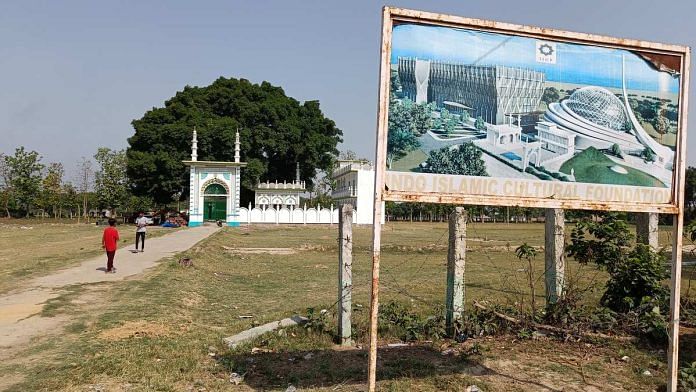Ayodhya: In the blazing May heat, Sohrab Khan stood in the middle of a vacant farmland, making a frantic call to get across to the district magistrate of Ayodhya. He was panicking about the two electric poles installed on the land.
Anywhere else, the villagers would have cheered this. But in the land allocated to Muslims to build a brand-new mosque to replace the demolished Babri Masjid, these electric poles are nothing short of a red flag. And a politically explosive one at that.
The message got through to the DM and officials swung into action. Within two hours, the electric poles were removed from the 5-acre plot that was given to the UP Sunni Central Waqf Board by the Uttar Pradesh government to build a mosque, following the Supreme Court’s landmark Ayodhya judgment on 9 November 2019.
Until the Ayodhya mosque is built, everyone is walking on eggshells.
But more than three years have passed since the land was received from the government, and not a single brick has been laid for the mosque in Dhannipur village, located on the Lucknow-Ayodhya highway, about 25 km from the Ram Janmabhoomi in Ayodhya.
While the construction of the Ram temple is reportedly more than 50 per cent done, with money pouring in from across India and a looming deadline of January 2024, the mosque is caught in a web of government and administrative hurdles.
“The PM to the CM visited the Ram temple site, but no one came to see the land of the mosque,” said a member of trust in charge of building the mosque— the Indo-Islamic Cultural Foundation (IICF).
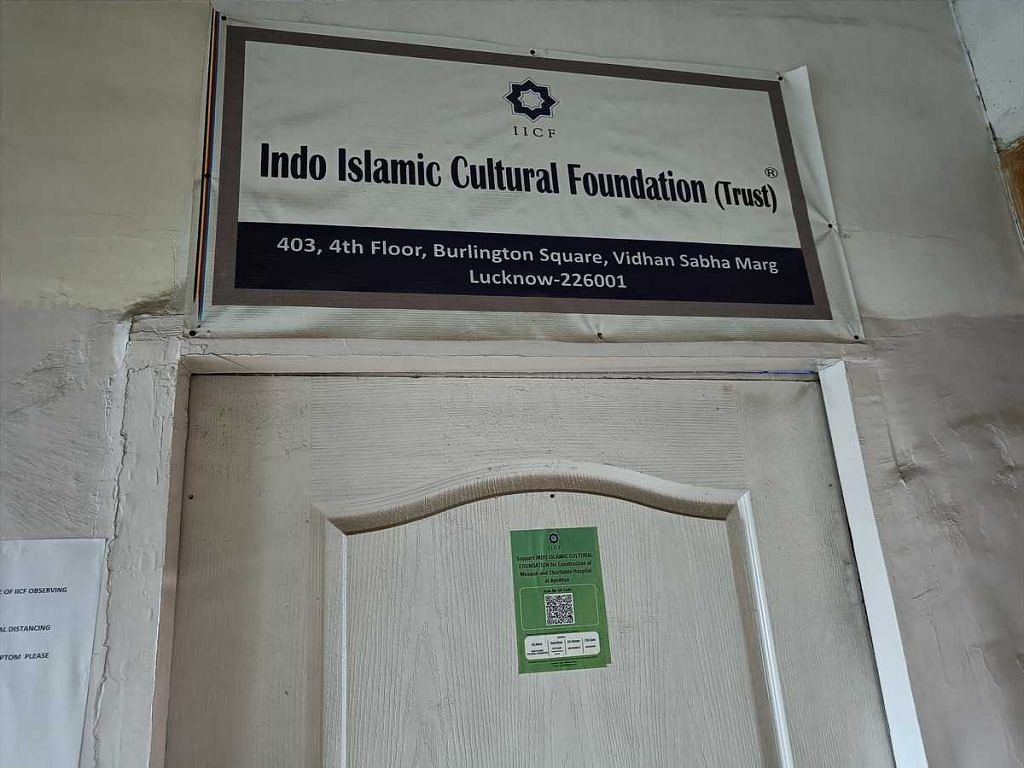
“Just like the government is getting work done for the Ram temple, the same should be done for the mosque too. Not much is in the hands of the local administration,” he added.
The mosque plan and the architect’s drawings are ready, the designers and workers are on standby, and the Muslim community is longingly keeping an eye on the Ram Janmabhoomi Temple construction. But the story of the Ayodhya mosque has been one of delays, despair, and doubts.
In the last three years, the mosque trust has been waging an exhausting battle against the red tape of NOC Raj. They struggled to get the coveted No Object Certificates from the authorities for fire, pollution, and land use.
Yet, it’s still not over.
Bigger challenges lie ahead — the mosque’s final map is lying uncleared at the Ayodhya Development Authority and money has to be raised to pay the exorbitant development charges and labour cess running into a few crores. So far, all that the trust has collected is Rs 50 lakh.
The entire project is estimated to cost Rs 300 crore and includes not just the mosque but also a hospital, community kitchen, and research centre. Just the mosque construction comes to about Rs 5-7 crore, said IICF secretary and trustee Athar Hussain.
“The issue of fees is still pending and the construction work will only start after getting the map approved,” said Sohrab Khan, appointed by the trust to take care of the mosque land.
Also Read: Frenetic work in Ayodhya — ‘Rs 3,200 cr collected, mandir 45% complete, darshan by Jan 2024’
‘Reconciliation won’t happen in a day’
On 9 November 2019, the Supreme Court in its judgment had asked the central or state government to give 5 acres of land for a mosque at a “prominent place” in Ayodhya.
Within three months of the decision, the Uttar Pradesh government announced the allotment of land in Dhannipur to the Sunni Central Waqf Board. A month later, in March 2020, the board formed a trust called the Indo Islamic Cultural Foundation, or IICF.
In December 2020, the trust presented its ambitious plan for a futuristic mosque complex, but getting it off paper has been difficult.
The office of the masjid trust is tucked away in Lucknow’s Ashok Singhal Chauraha— named so last September after the late Vishwa Hindu Parishad leader, one of the most prominent faces of the Ram Mandir movement.
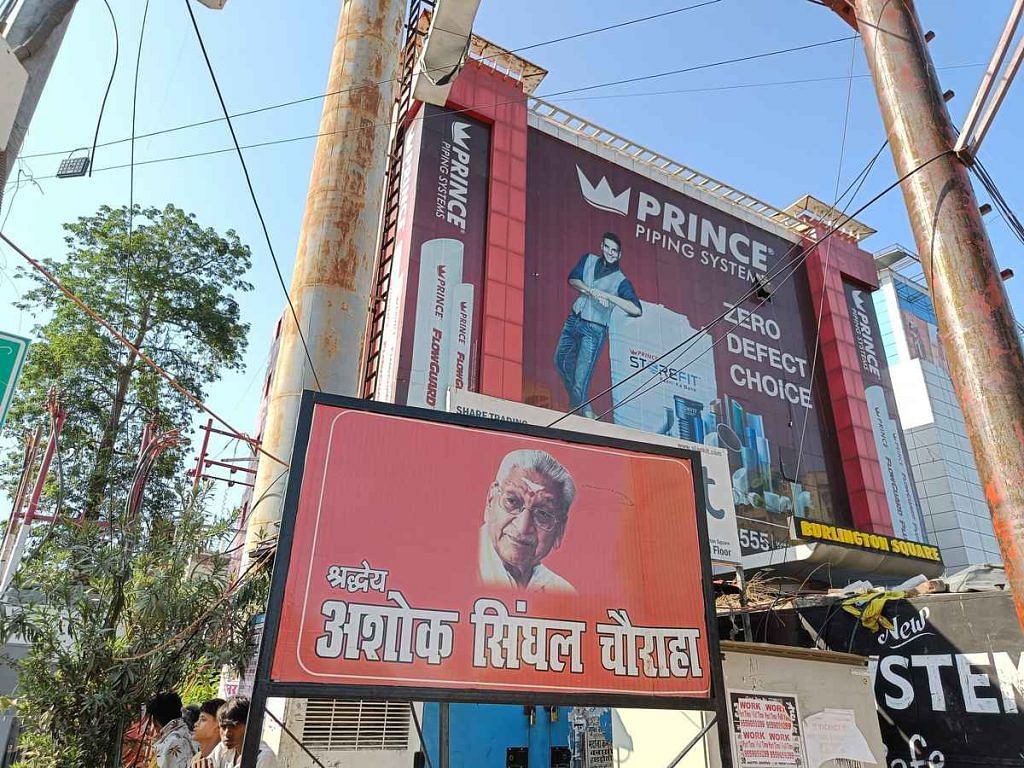
This office runs from a room on the fourth floor of a building named Burlington Square, just behind a signboard featuring Singhal’s visage. Not many here seem to know about it.
Seated in this modest room, trust secretary Athar Hussain confirmed that the Ayodhya Development Authority (ADA) issued a land use clearance in March, but the development fees have become a big hurdle.
He said that if the government doesn’t exempt the development fee, the trust will submit a new design plan featuring only the mosque and not the other buildings in the proposed complex.
“So far, only Rs 50 lakh has been collected. We are asking the government to waive the development charges, which are estimated to run to a few crores. If this does not happen, then first we will build the mosque. After that we will resubmit the design for the hospital and other buildings to ADA,” he said.
The other problem is that the land allotted to the new Ayodhya mosque is very far from the main city — over 25km away. And there are many other functioning mosques there already.
“Where land has been given, there is no need for a mosque as there are already many mosques there. The mosque is not built for numaish (showcase) but for ibadat (worship). The intention of the trust has not been clear, so till date even their map has not been passed,” said Iqbal Ansari, one of the main litigants of the Muslim side in the Ayodhya dispute.
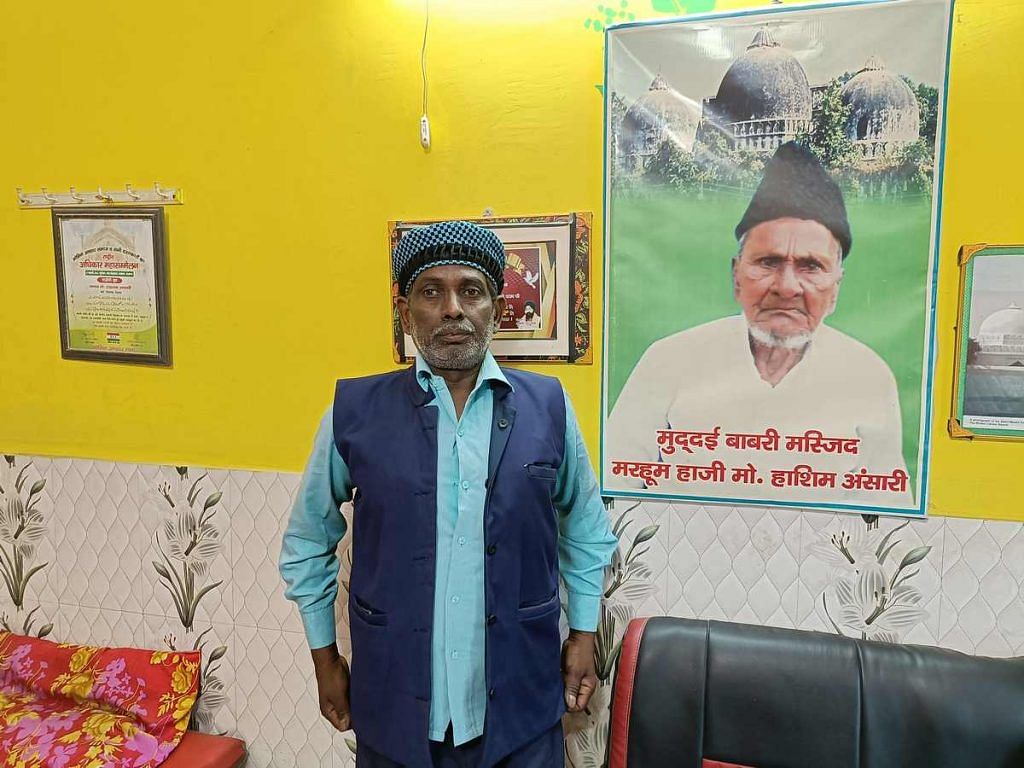
Ansari said that the land given for the mosque was earlier used for farming and its original purpose should not be altered.
“There should be cultivation there. The crop should be divided among Hindus and Muslims so that a message goes to the whole world that the property given for the mosque after the Supreme Court’s order is being used for the welfare of the poor,” he added.
But keeping aside all the issues about land, fees, NOCs, and the long delay, many Muslims here say that the endeavour to build the mosque should not turn the city into a flashpoint and subject of national headlines again.
“Hindu-Muslim relations never deteriorated in Ayodhya. The situation that happened in 1992 was created because of people from outside. Everyone has to understand that religion has not benefited anyone,” Ansari said.
Hussain, however, said that accepting the land conveyed reconciliation.
“After the 2019 verdict, some social and political Muslim leaders and clergy opposed the land given for the mosque but we accepted it with an open heart,” he said.
“Reconciliation is an ongoing process. It will not happen in a day. This matter has been going on for 150 years. It will take time to restore mutual trust,” Hussain added.
According to the 2011 census, Ayodhya city comprises 84.75 per cent Hindus and 14.80 per cent Muslims. In 2018, the Yogi Adityanath government had renamed Faizabad district as Ayodhya.
Also Read: There are 3 claims to Ayodhya — law, memory & faith. It’s not a simple Hindu-Muslim dispute
Four boards, a tomb, and a jackfruit tree
Wheat and rice crops once flourished in the designated mosque site, which was previously under the jurisdiction of the state agriculture department.
Since the land acquisition in 2020, farming has stopped here, with only a few irrigation drains serving as reminders of its past.
Located between the villages and fields of Dhannipur and Raunahi in Ayodhya’s Sohawal tehsil, the mosque plot is easy to miss unless you’re looking for it.
Despite symbolic gestures like the planting of a few saplings by the trust on 26 January 2021, progress has been minimal over the past 3.5 years.
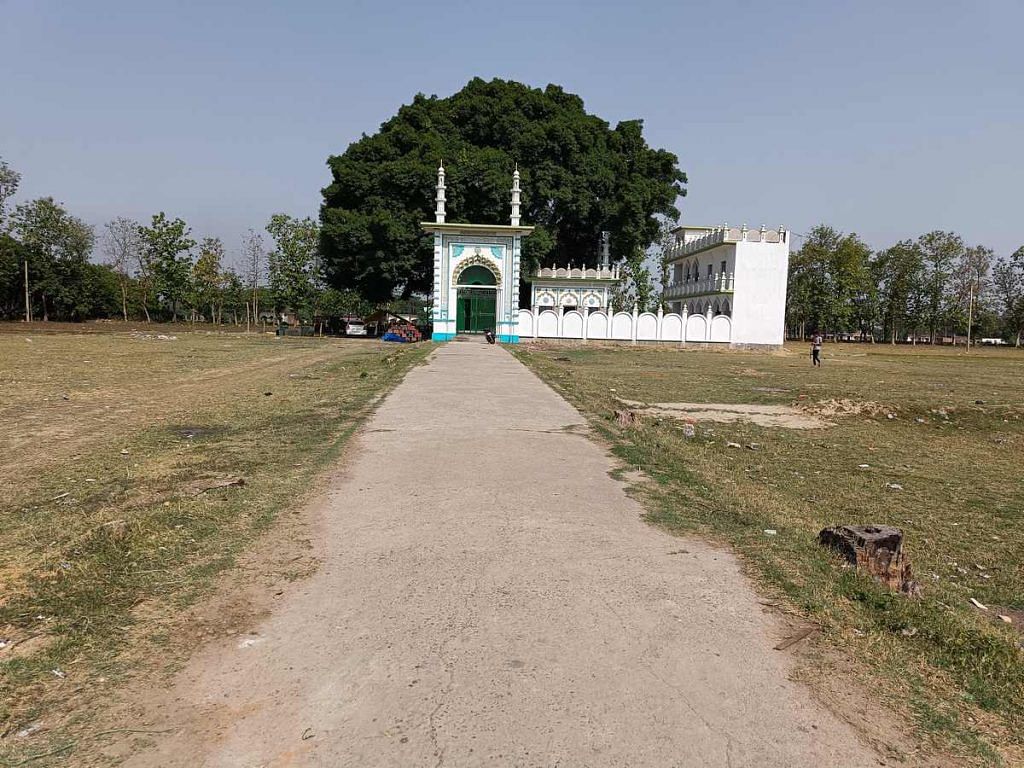
The Indo-Islamic Cultural Foundation has yet to fully fence the land and only four trust boards can be seen in the vicinity. One of these is obscured by a large poster for a horse racing competition, and is surrounded by a pile of garbage. Another sits next to a large jackfruit tree and a defunct hand pump.
At the centre of the plot stands the white mausoleum of Hazrat Shahgada Shah, a Muslim saint.
The mosque grounds serve as the venue for the annual urs (commemorative festival) at the tomb every April, drawing crowds from neighbouring villages. Other than that, not much happens here.
Locals say that trust officials visit the site only on 15 August and 26 January to hoist the national flag and distribute balushahis and samosas. During these events, villagers congregate to sing the national anthem.
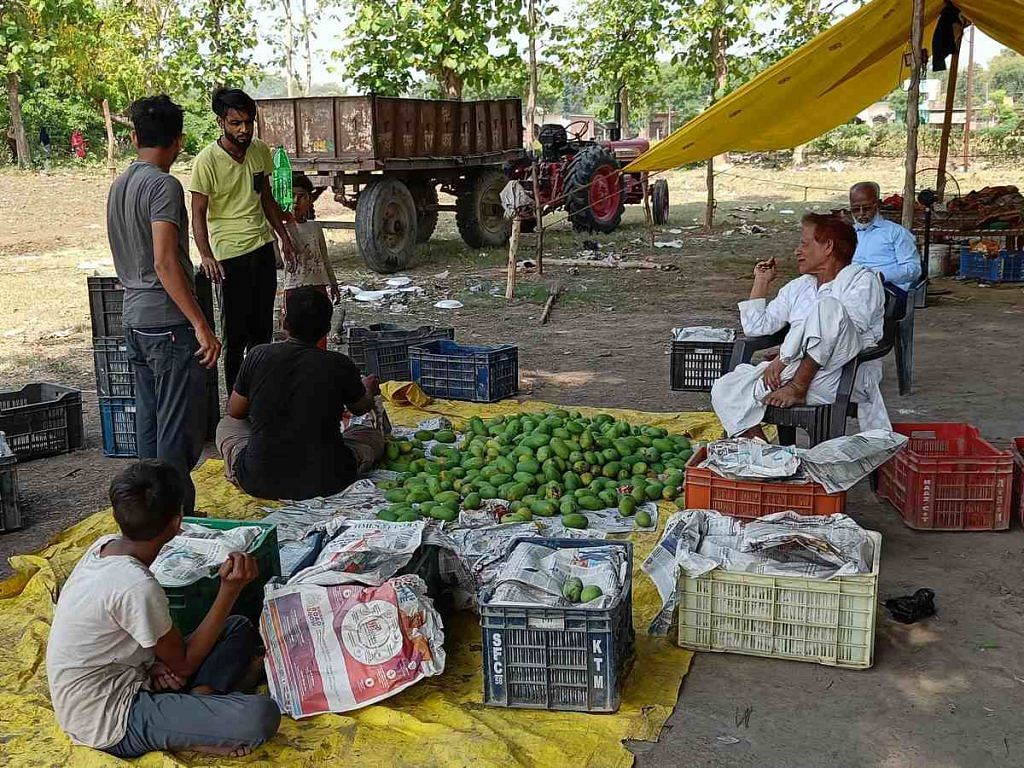
When ThePrint visited the site at the end of May, workers from an adjoining mango orchard had set up makeshift tents where they were packing fruit. And in the evening, children played cricket here, making wickets out of bricks.
Administrative wrangles, ‘political obstacles’
Construction is on at full clip for Ayodhya’s Ram temple, which is expected to be completed by January 2024. Even the area around the temple is getting a makeover. Ghats and ponds are being beautified, houses near the Janmabhoomi area are getting a ‘heritage’ facelift, and infra like new parking lots and a swanky new railway station is being swiftly set up.
But no frenetic economic activity is being done around the mosque site. There is only a single board of Dhannipur in the whole area.
IICF trustee and secretary Athar Hussain said that there cannot be a comparison between the Ram temple and this mosque.
“Preparations have taken place for the Ram temple for decades. The land was given for the mosque only after the decision of the Supreme Court. First, Covid derailed the project and then there was a delay in getting some NOCs,” he said.
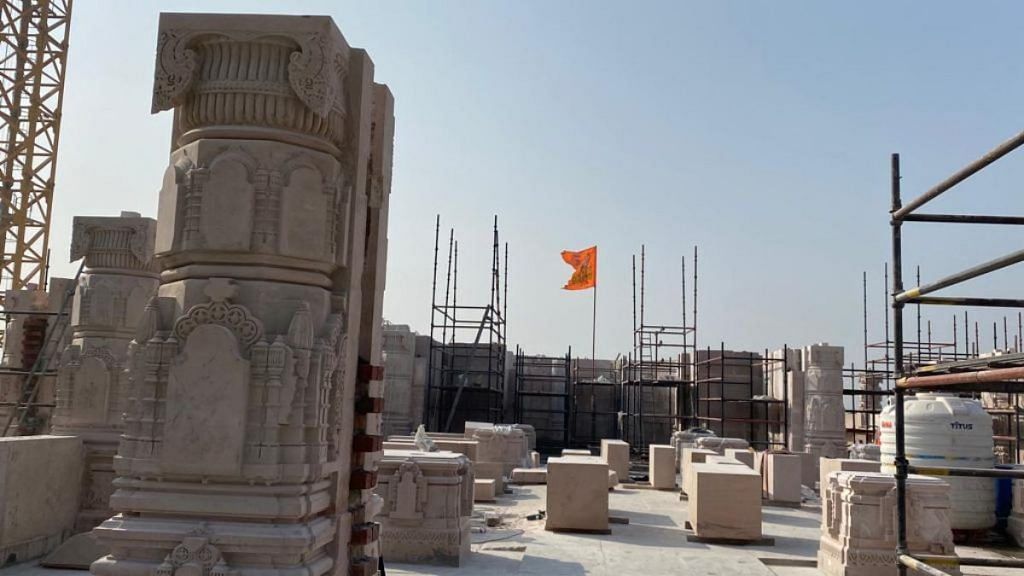
So far, 10-12 meetings of the trust have been held, most of them online. The trust can have a maximum of 15 members but currently it has only 12.
In July last year, the trust appointed senior journalist Bobby Naqvi as its strategic advisor. Zafar Farooqui, chairman of the Sunni Central Waqf Board, is the chief trustee of the trust.
The trust has had two meetings with the Ayodhya Development Authority, or ADA, so far.
“Our talks with ADA have been good,” Hussain said.
But with a tangible outcome yet to be seen, there are rumblings that paperwork is not the only problem.
A member of the masjid trust alleged that more than administrative delays, a lack of political will was hindering the project.
“Due to political hurdles, the work of the mosque has not progressed since the beginning,” he said.
This trustee also alleged that there were unequal requirements in the NOC application process for the temple and mosque.
“The facility to apply offline for NOCs was given for the Ram temple, but we were asked to apply online through the Nivesh Mitra portal of the UP government. Dozens of NOCs are required in the online process,” he claimed.
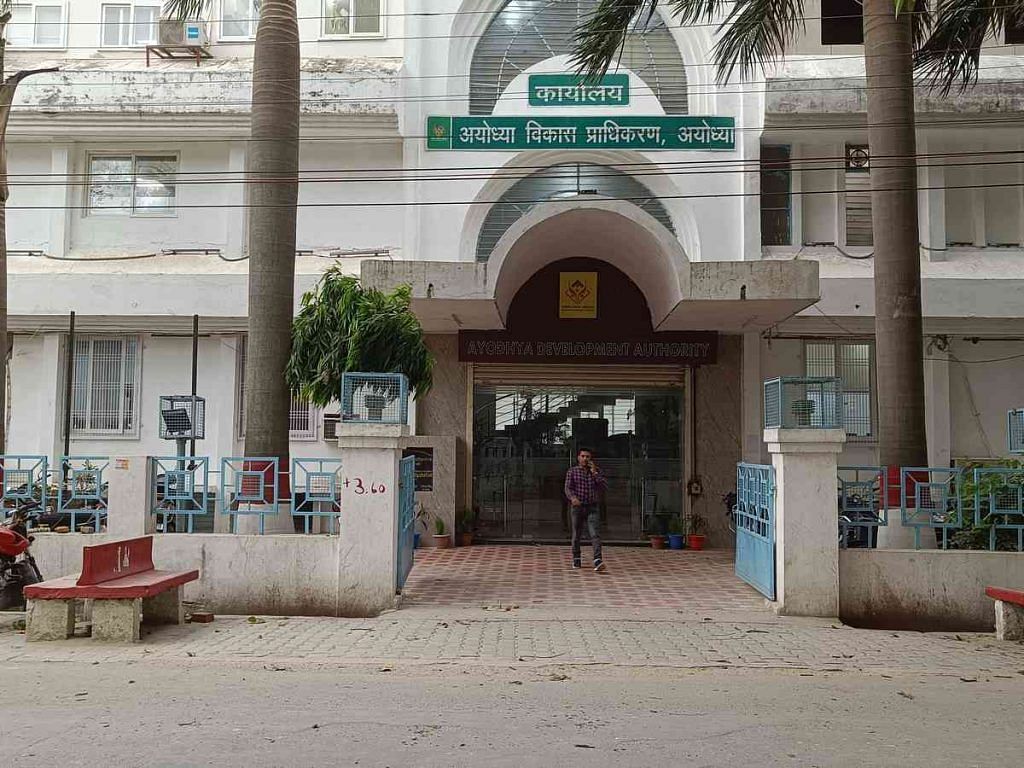
However, ADA secretary Satyendra Singh refuted the charge that the mosque trust was not given the facility to apply offline.
“The mosque trust also has both the online and offline options. They simply do not want to deposit the development charges,” he said.
These additional charges and taxes have become the subject of a tussle. Members of the trust say that they are seeking an exemption for two reasons— a paucity of funds and to avoid conveying the “wrong message” to Muslims.
Trust secretary Hussain argued that the Muslim side had never demanded an alternate piece of land, but now that it had been granted, paying so much tax on it seemed to go against the spirit of things.
“People will feel that instead of building a mosque with that money, it is going to the government. It will lower the morale of the community,” he said.
ADA’s Singh, however, said no development charges meant no mosque.
“If these people pay the development charge, then only we will get the development done there,” he said, pointing out that the mosque area falls within both the masterplan and the extended area of the ADA’s authority.
“The expenses of the authority come out of this money, how will work be done without the development charge? If they submit all the things to us then we will pass their map in 24 hours,” he added.
Singh said the trust could try to approach the government, but it would likely not bear fruit. No government would like to bear the loss of revenue, he said. The temple trust, he added, had submitted all its dues to the ADA on time.
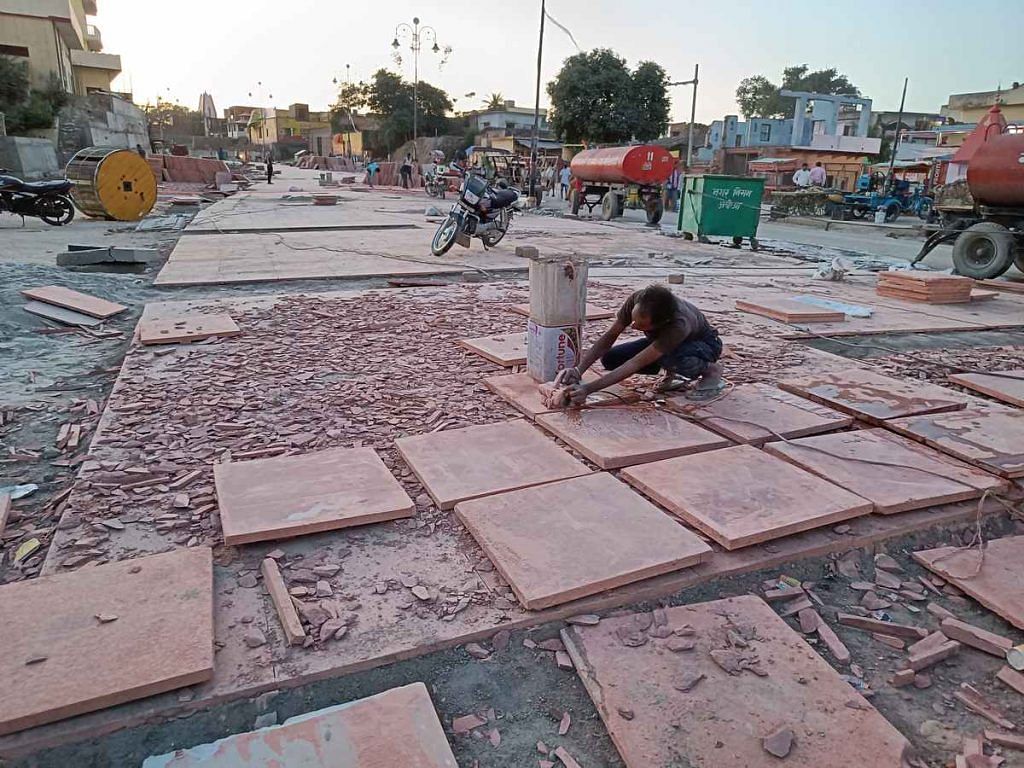
“Everyone knows how important the temple is for the government. If a waiver is given, then everyone will start asking for an exemption,” he said. “The mosque trust is only doing politics. They say that we should do everything and give it to them. There is no professionalism in them at all.”
When asked about the delay in the mosque’s construction, Champat Rai, general secretary of the Ram Janmabhoomi trust, distanced himself. “This is not my subject,” he said.
The Babri Masjid was destroyed on 6 December 1992 because of “samajik bal (social force)”, he added, but the onus of constructing a new mosque was on the masjid trust.
“You have to build a house (masjid). When will you make it, you know,” Rai said.
Old baggage, Shariat controversy
The mosque trust has decided that the name of the new mosque in Dhannipur will not be Babri Masjid. The trust claims it wants to move forward by removing the baggage of the past.
Members of the trust highlight the symbolic “importance” of the land. They say it is no ordinary piece of property.
“The Supreme Court gave a decision in favour of the Ram temple using a special provision. Clearly, injustice has been done to the Muslim side. The court could not decide the title suit. This is the first mosque in the country which is being built on the orders of the Supreme Court,” said a member of the trust.
He added that the Muslim community was “shocked” by the 2019 verdict but had decided take the higher ground and be patient.
“The government should now openly support the construction of the mosque. The Babri Masjid was demolished in 1992 while under the protection of the government, compensation should be given for it,” he added.
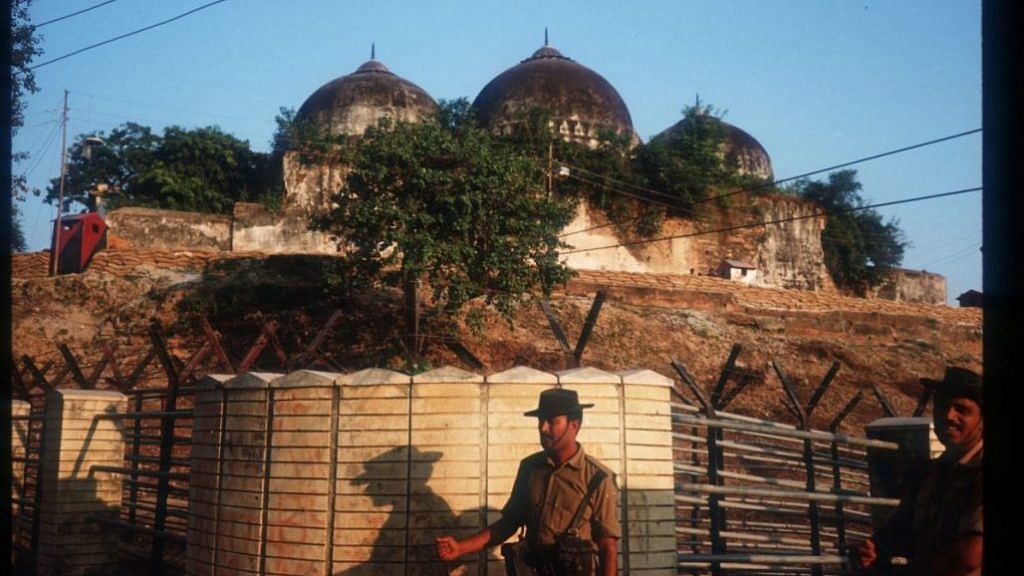
However, others in Ayodhya’s Muslim community are impressed neither by the significance of the land nor the new nomenclature for the mosque.
“Neither is it in the centre of Ayodhya and nor is it named Babri Masjid now. Even if the name Babri Masjid had been kept, people would have come to see it,” said Badshah Khan, president of the Ayodhya chapter of Islamic organisation Jamiat Ulema-e-Hind. “The government has cheated the Muslims.”
Both Badshah Khan and Ayodhya litigant Iqbal Ansari express reservations about accepting the land from the UP government.
Ansari said that many Muslims believe that the Supreme Court’s decision to grant land to the Sunni Waqf Board—which comes under the UP government — was unjust. He is so averse to the idea he has never even gone to see the mosque site
Ansari claimed that many Muslims are not supportive of the trust and also criticised the “videshi naksha” (foreign design) of the mosque.
There is also the Shariat debate over the mosque.
Soon after the Supreme Court’s verdict, members of the All-India Muslim Personal Law Board (AIMPLB), voiced concerns that building the proposed new mosque violated the Waqf Act and was illegal under Shariat law.
“According to Shariat law, neither the mosque can be sold nor its use can be changed. Replacement of the mosque is illegal. The Muslims did not accept it,” explained Khaliq Ahmed, the nominee of Maulana Mahfuzur Rahman, one of the litigants in the Babri Masjid case.
But when asked about the controversy, AIMPLB member Khalid Rasheed Firangi Mahali said that nothing would be achieved by raking up the issue.
“To speak on this is to trouble oneself. This issue is over. All we want is that the mosques that are already there should remain safe,” Mahali said. Sources in the AIMPLB said that the Babri Masjid issue is no longer raised in the board’s meeting.
Ahmed said that the Sunni Central Waqf Board works under the UP government.
“Chief Minister Yogi Adityanath promoted the temple but did not promote the mosque. He is looking at his vote bank. By building a mosque, he will not allow his vote bank to be negatively affected,” he said.
Hussain, meanwhile, said everyone interprets Shariat differently. “The land is allotted under the directives of the Supreme Court, it cannot be illegal,” he added.
Also Read: Waqf boards are India’s big urban landlords. But whose interest are they serving?
‘No need for mosque’, but dreams of ‘development’
The mosque land has brought a bit of fame to the podunk town of Dhannipur. Many residents now hold out hope that once the mosque is built, business will boom in the whole area and that the hospital will provide much-needed medical care.
“I can hardly earn Rs 300-400 in a whole day. After the construction of the mosque, many people will come here. Our business will increase. The whole area will shine,” said Mohammad Shafiq, who runs a grocery shop near the mosque land.
Dhannipur, home to 2,000 people, and its adjacent village Raunahi, with a population of about 10,000, are served by 14-15 mosques catering to their substantial Muslim communities.
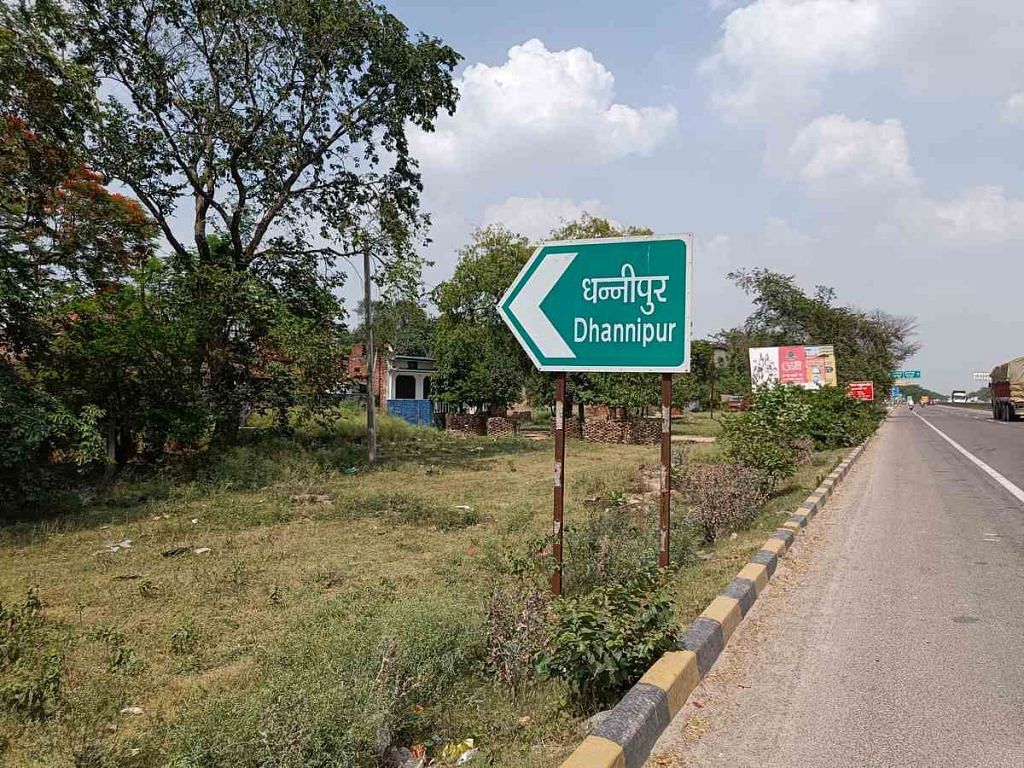
Locals say they don’t really need a new mosque, but many are enthusiastic about the proposed hospital and research centre.
“There are many places of worship here, but there is a great need for a hospital. Now people go to Lucknow or Faizabad for treatment,” said Abdul Ahda, a Raunahi resident who also takes care of one of the mosques of this area.
Shrinath Yadav, a farmer who lives in Dhannipur, is similarly hopeful.
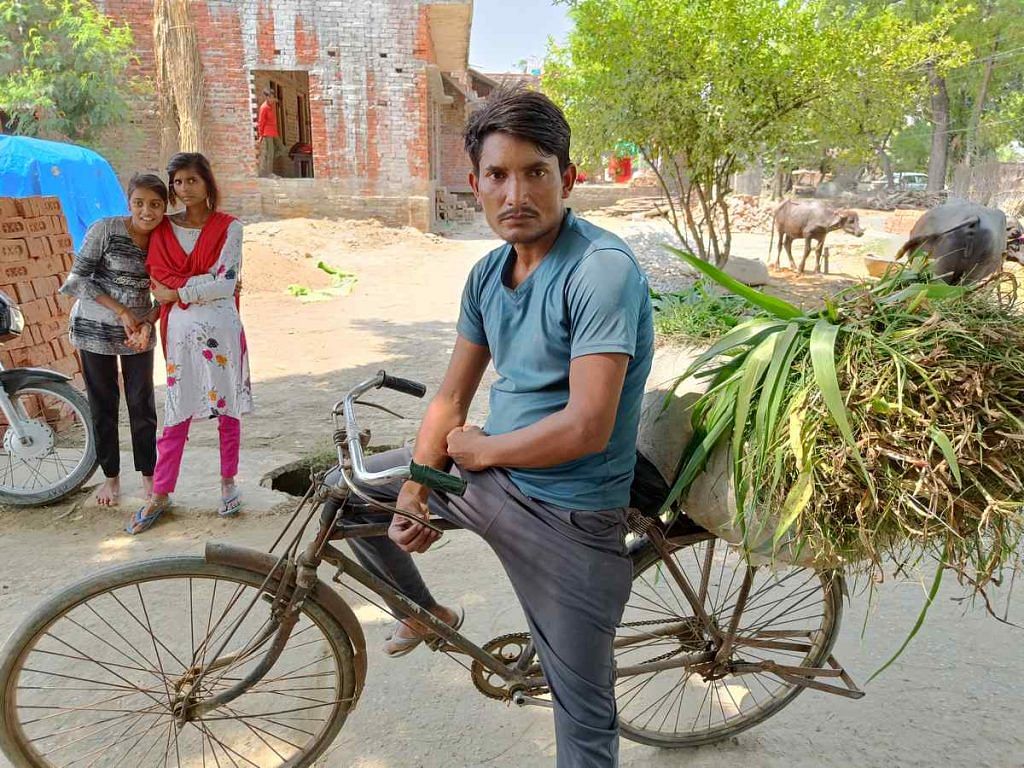
“It is being heard that a hospital will be built here. Due to this, people are happy. Common people will only get the facility,” he said.
Apart from this, the prices of the lands around Dhannipur have also started rising.
“The importance of our lands here has increased a lot. The prices have increased 5-7 times as compared to earlier,” Yadav said.
Also Read: No domes, no minarets — Ayodhya’s new masjid to replace Babri gets a futuristic design
An ambitious plan
On 19 December 2020, trust members and architect Prof S.M. Akhtar unveiled the design of the mosque complex.
The vision for its buildings is futuristic, symbolic not just of innovation and modernity but of leaving the past behind.
The mosque, for instance, is egg-shaped and eschews traditional elements like a dome or minarets. The structure will incorporate renewable energy sources such as solar and wind power, and the IICF plans to plant saplings from all over the world to take the green message a step further.
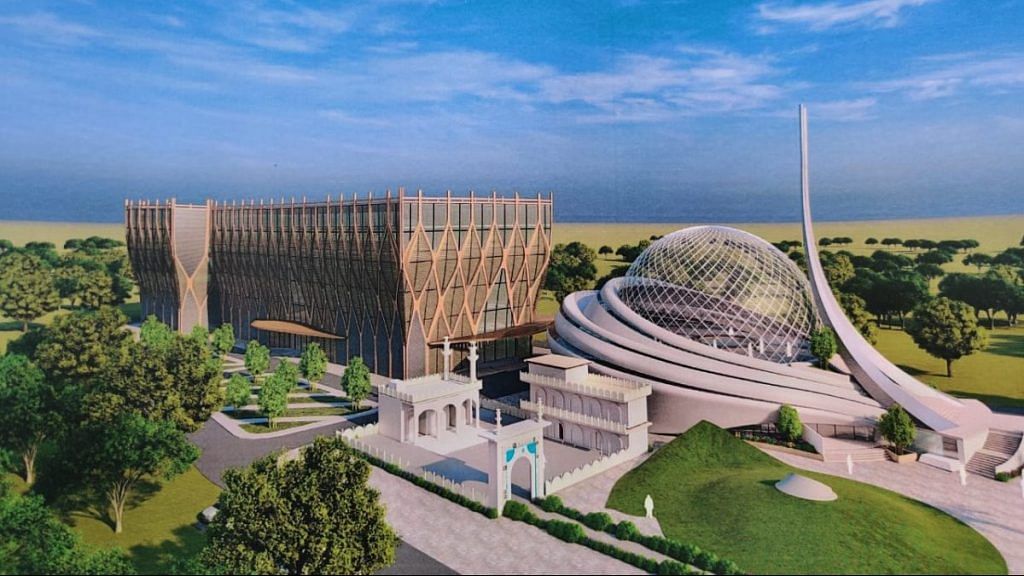
The proposed complex spans 4,500 square metres, encompassing a research centre, museum, a 200-bed hospital, and community complex.
The hospital (24,150 sq m) is expected to be six times larger than the mosque (350 sq m), according to the IICF plan, seen by ThePrint.
Prof Akhtar, who designed the mosque project, said that he visited the land twice before drafting the plan. “It is a very contemporary and modern design, which has been made with new thinking,” he said.
When asked about the proposed materials for the project, he said steel and stone would likely be used.
“The only objective is that the structures should last for a long time. Other things will be decided only after the work of the mosque starts,” he said.
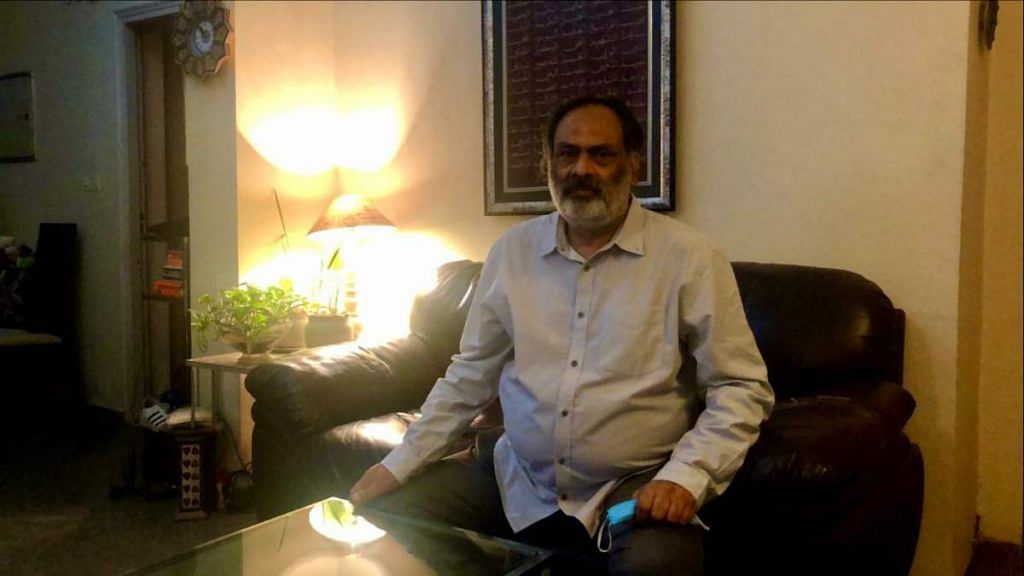
The IICF aims to utilise the mosque complex to practice the basic principles of Islam: healing, feeding, and preaching.
There are also plans to propagate a message of communal harmony in the museum and research centre by highlighting the stories and achievements of India’s Muslim heroes. One such is Maulvi Ahmadullah Shah, a 19th-century freedom fighter from Faizabad who is often held up as the epitome of religious unity and Ganga-Jamuni Tehzeeb in the region.
“The whole of Awadh was not divided at all in the name of religion. We want to take these things to the people,” said IICF secretary Hussain.
Maulvi Ahmadullah Shah’s martyrdom day is observed on 5 June and the trust had last year organised a programme in its Lucknow office to commemorate his role in the 1857 revolution.
Another member of the trust said the research centre will also showcase the role of Muslims in nation building.
“This will be the answer to the propaganda spread by the RSS. The whole project will convey that Islam is the religion of humanity and open a new window towards it,” he said.
Apart from this, a community kitchen will provide free food to visitors for about 12 hours a day and every day’s menu will be different, said trust members. Respected food historian Pushpesh Pant will curate the menu, drawing inspiration from the flavours of Awadh.
But the biggest priority of all is the hospital, Hussain said.
“This project will be run on a charity model. However, if we are unable to start it due to lack of funds, we will still select 100 people from this area every year and provide them with free treatment,” he added. This treatment will be for serious conditions such as cancer and heart disease.
According to the trustees, funds for the hospital will be raised from big business houses, but these will require the final map to be approved before contributing.
The IICF is raising funds online for the masjid and charitable hospital, but so far only Rs 50 lakh has been collected. It’s a stark contrast to the over Rs 3,200 crore raised for the Ram temple.
“The Muslim community is not so prosperous that they can donate huge amounts. We had raised funding from some places, but once the map is passed, we will try to raise funds on a larger scale,” Hussain said.
According to media reports, many donations for the mosque have come from the Hindu community.
The long wait to realise the vision for the mosque complex, though, is taking a toll.
“Three years have passed. This is a long gap in modern architecture,” Prof Akhtar said. When the work starts, then many more structural changes will have to be made in the design so that the architecture is according to the time.”
Caretaker Sohrab Khan, meanwhile, keeps wishing for a stroke of luck.
“On one side, the Ganga of development is flowing around the temple in Ayodhya,” Khan said wistfully. “I wish a drop of that Ganga would have fallen around the mosque as well.”
(Edited by Asavari Singh)



